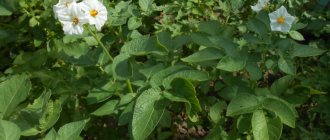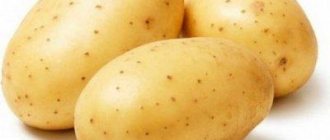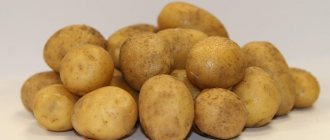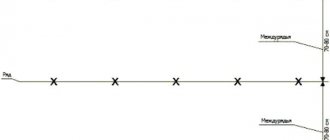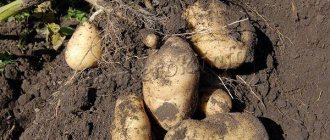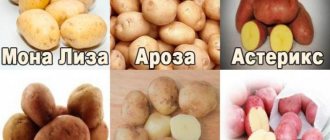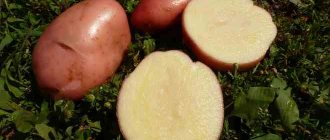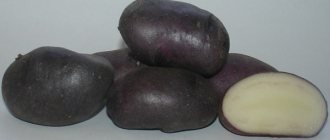Vegetable growing » Potatoes
0
1357
Article rating
Kira Stoletova
Inara potatoes are early ripening table varieties. The species was bred in Germany. It has high quality indicators and good external data. Suitable for preparing various dishes, retains color and shape during heat treatment.
Description of Inara potatoes
Origin story
The authors of the variety are breeders from Norika Nordring Kartoffelzucht und Vermehrungs GmbH. Norika has fifty years of experience in successfully breeding and growing elite potato varieties. It is noteworthy that the Inara variety was obtained in the climatic conditions of the island of Rügen, located in the Baltic Sea, which in their severity resemble the Central and Middle regions of the Russian Federation.
It is noteworthy that the creators of the Inara variety continue to supervise their product, issuing licenses for the cultivation of seed material to German farmers, as well as monitoring the varietal qualities of Inara from official distributors in the Arkhangelsk region and in other regions of Russia, involved in the popularization of varietal potatoes of the German company.
Potatoes of the Inara variety have passed phytosanitary control on the territory of the Russian Federation and are allowed for distribution and cultivation. Currently, the variety is widespread not only in the recommended areas, but also in the south of Russia.
Features of planting, growing and care
Growing blue potatoes in your garden is no more difficult than usual. There are care recommendations that promote high yields.
First of all, it is important to select proven seed material. One month before planting, the tubers are germinated in a warm room where the temperature is maintained at +15-+19°C
Soil for potatoes
It is important to think about the landing site in advance. The area should be illuminated by the sun
Preferably southern and southwestern areas. The soil needs to be dug up in the spring and preferably in the fall, to saturate the soil with oxygen. The plant takes root on chernozem, soddy-podzolic soils with neutral acidity. To increase productivity, mineral or complex fertilizers should be added at the time of digging. The culture responds with rapid growth to nitrogen, potassium and phosphorus fertilizers.
Swampy places where water regularly stagnates are not suitable for planting. The soil should be fluffy and loose, in this case the yield percentage is higher.
The plant is planted at a time when the earth is warmed by the sun to +4-+6°C. In Central Russia, planting occurs at the end of April - beginning of May. The growing method can be soil, straw, bags, etc.
The classic option for planting in the ground:
- Furrows are made with a depth of 10 to 15 cm. The seeds cannot be buried, otherwise they will take a long time to germinate.
- Organic fertilizer, such as wood ash, is added to the center of the hole. A layer of earth is poured on top and leveled.
- The distance between potatoes is 25-30 cm.
- A suitable distance between grooves is 30-40 cm.
In cold regions, plantings are covered with film to create a greenhouse effect and protect the plant from possible frosts. The covering material is removed when the seedlings begin to hatch.
After planting, we must not forget about watering the crop.
It is important to monitor the condition of the soil to avoid dryness or excess moisture. Overwatering leads to rotting of the roots, increasing the likelihood of insects
The bushes require increased watering after germination. Then after the buds set and at the stage of flower fall. Weekly sprinkling in small quantities leads to the growth of green mass.
Purple potatoes suffer from leaf blight more than other crops. The plant is actively eaten by the Colorado potato beetle and aphids. They need to be dealt with immediately in order to save most of the harvest. Ways to get rid of diseases and insects can be traditional or using chemicals
It is important to remember that you need to apply insecticides a month before harvesting vegetables. Disease prevention is considered to be the treatment of seed material with disinfecting solutions and compliance with crop rotation.
Weeding and hilling of purple-skinned potatoes is most required during the flowering stage. Additional saturation of the soil with air will benefit the root system of the crop.
Growing and yielding purple potatoes
Description and characteristics
The Inara variety is distinguished by medium-sized bushes, up to 80 cm in height. It has erect, succulent stems compactly arranged around a basal rosette. The color of the stems and leaves corresponds to the generic characteristics of potatoes:
- light green - at the beginning of the growing season;
- dark green shade in the flowering phase;
- yellow and brown - in the phase of biological maturity.
The leaves of the plant are paired, oval in shape, slightly pointed at the tips, on short petioles, with a relief pattern.
During the flowering period, potatoes throw out flower stalks in “clusters”. The Inara variety has white flowers with yellow bases on the sepals.
The root system of potatoes is located close to the soil surface and has a fibrous structure. Inara forms 8-10 tubers on stolons, weighing from 80 g to 140 g. The number and weight of tubers depend on agrotechnical and climatic factors.
Inara potatoes are popular due to their universal table qualities, the correct shape of oval tubers, without deep eyes. The peel at the stage of biological maturity has a golden-brown hue, the flesh of the tubers is moderately dense, cream-colored when raw, white after heat treatment.
Description of the potato variety Inara
Potato Inara is a variety of German selection, bred by specialists of the Norica company (Gross Lyuzevtsi, Germany). It passed successful tests in Russia, and in 2013 it was included in the register of breeding achievements. Recommended for cultivation in the middle zone and in the Volga-Vyatka region. It is unpretentious, so it can be bred in other areas, including the Urals and Siberia.
Main characteristics of Inara potatoes:
- table (starch content 12-15.5%);
- early ripe (technical ripeness after 45 days, biological ripeness after 80);
- medium or tall (up to 70-80 cm);
- plant of intermediate type.
Inara potato bushes are semi-erect or erect, quite compact. The leaves are small, green, with pointed tips. Their petioles are small, their surface is textured, and they are located in pairs on the stem. The shoots are strong and thick. Moreover, the color of the branches and foliage changes noticeably over time:
- after emergence – light green;
- during flowering – dark green;
- after the tubers finally ripen - yellowish with brown tints.
The flowers of the Inara potato are white, with yellow stamens. Flowering is lush and abundant. Moreover, already at a temperature of 23-25 degrees the plant sheds its inflorescences. At this point, the tops can be irrigated with water, preferably in the evening. The root system is fibrous and lies close to the surface layer of soil, so it is better to plant tubers deeper (especially if the soil is light and loose).
The tubers of the Inara potato are elongated-oval, the eyes are small. The surface is smooth, yellow. The dimensions are quite large - 3-5 cm in diameter, weight 100-120 g. The pulp is dark yellow when cut, boils soft. The taste according to the registry is good.
Important! The yield of commercial Inara potato tubers ranges from 89% to 96%. The variety can be bred not only for personal consumption, but also for sale.
The length of Inara potato tubers reaches 10-12 cm
Advantages and disadvantages
Inara requires standard conditions of agricultural technology, like any potato variety, and only if all the rules are followed can the advantages of the variety be discovered.
| pros | Minuses |
| Suitable for technical cleaning due to the smooth and even surface of the tubers | |
| Productive variety – 25-42 kg/m2 | |
| Standard agricultural technology | |
| Resistance to scab, stem blight, nematodes, rot, potato blight | |
| Satisfactory table quality, starch content 11-14% | |
| Keeping quality 96% | |
| Does not lose density or taste during storage | During storage, requires regular inspection and removal of sprouts |
In addition to compliance with agricultural technology, it is necessary to take into account regional weather and climatic conditions, and soil composition. The quality of the variety is significantly influenced by the seed material.
Immunity
The main diseases that the Skazka variety may encounter are:
- Late blight.
- L-virus.
- Rhizoctoniosis (black scab).
Late blight
When a crop is affected by this disease, yellowing of the leaves and the appearance of dark spots on the root crops are noted. An infected crop loses at least 10% of its total yield.
The main preventive measure is the selection of seed material.
L-virus
The first sign of this disease is curling of the leaves. The carrier of the disease is aphids.
Preventive measures include selecting high-quality seed material and destroying aphids.
Black scab
When this disease manifests itself, netted spots appear on the tubers, the stem becomes thin, and the plant begins to slow down in development. A crop affected by the disease loses from 10 to 40% of its yield.
The main preventive measure is compliance with crop rotation and selection of high-quality planting material.
Landing
Planting potatoes begins with preparing the soil immediately after harvesting. The area where potatoes were grown should be given special attention if it is not possible to follow the rules of crop rotation.
- After harvesting potatoes, be sure to clear the area of tops. It is taken outside and burned to avoid soil contamination by infectious agents.
- If the area of the plot is limited, in order to comply with the rules of crop rotation, after harvesting the potatoes, it is advisable to plant spicy leaf crops, radishes or radishes, lettuce, some types of cabbage, and legumes on the plot. Since the harvesting period for Inara potatoes begins in June, you can get a double benefit: improve the soil composition and get an additional harvest of other, early-ripening or frost-resistant crops.
- In the fall, the area planned for growing potatoes is dug up to a depth of 30-40 cm, manure is added (10 kg/m2), since potatoes produce an excellent harvest when grown in soil enriched with organic matter.
- In the spring, when re-digging and loosening the soil for planting potatoes, you should definitely add urea, nitrogen, potassium and phosphorus mineral fertilizers.
Advice! To destroy weeds and larvae of garden pests remaining on the site after harvesting, 7-10 days before autumn digging, in warm and dry weather, treat the soil with insecticides and herbicides.
This measure will increase the future potato harvest by 15-20%.
The Inara variety, like all potato varieties, prefers fertile and light soil, with good aeration and moderate humidity. Therefore, it is important to improve the composition of clay soil by adding sand and dolomite flour. Potatoes are not very sensitive to soil acidity levels, and high humidity can cause many diseases, spoil the varietal qualities of Inara potatoes, and shorten shelf life.
Before planting, it is necessary to place the tubers in a warm room and germinate for 20-30 days. The strongest sprouts are left on the tubers, and the rest are removed. For rapid germination, tubers are treated with biostimulants - this technique allows you to get a healthy harvest with a good increase, and also largely regulates the optimal timing of planting the mid-early variety Inara.
Planting patterns may vary. In private household plots, where planting and harvesting potatoes is carried out manually, two traditional methods are mainly used: trench and square-cluster. 5-6 tubers are planted per square meter of plot, leaving such a distance between future plants so that the grown bushes close together, forming a microclimate in the root zone. But at the same time, you should not thicken the plantings so much that the plants interfere with each other in the development of tubers.
Therefore, the optimal distance between rows of the Inara variety, taking into account the structure of its bushes, is 50 cm. The distance in the row should be the same. It is allowed to shift the planting pattern by 10 cm towards increasing row spacing or in rows. The 50x70 cm pattern is used when growing beans and potatoes at the same time.
Attention! Beans are a natural protector of potatoes from the Colorado potato beetle and a source of nitrogen in the soil.
In addition, beans can protect potatoes from the heat, serving as a backdrop crop.
The depth of planting of tubers depends on the composition of the soil:
- 5 cm – for clay soil;
- 10-12 cm – for loam;
- 14-16 cm – for sandy soil enriched with organic matter and mineral complex.
When planting potatoes, phosphorus and potassium fertilizers are applied to a hole or trench. The timing of planting prepared seed material is determined by regional weather conditions. It must be taken into account that the technical ripeness of Inara potatoes occurs 40-45 days after emergence, and biological maturity occurs after 80 days.
Growing
Plants need to be looked after
The main rule for growing this type of potato is to observe crop rotation. You should not take seed potatoes from the first year of planting for propagation. The variety is not prone to degeneration. To get a good harvest, you should perform a number of agrotechnical measures:
- choose the right site;
- prepare the soil;
- select planting material;
- provide good care after planting.
Inara potatoes are a heat-loving plant, so it is better to choose well-lit areas. It is not recommended to plant potatoes on slopes. The best yields are observed on fertile soils and sandy loam soils.
It is recommended to plant from north to south. This way, each plant will receive enough light, and the bush will develop evenly. The larger the potatoes selected for seeds, the wider the step should be taken between the holes.
Preparing the garden
When planting varietal potato varieties, it is imperative to follow the rules of crop rotation. You cannot plant potatoes in the same place, or after tomatoes, eggplants and cabbage. During the autumn cultivation of the site, it is recommended to apply herbicides. These drugs help disinfect the soil, effectively remove the roots of weeds and destroy the larvae of all kinds of parasites. If possible, add sand to soils that are too hard.
The soil is cultivated to a depth of about 30-40 cm. Fertilizers are applied. At this stage, you can use unrotted compost or fresh manure.
Seed preparation
Potatoes from the first year of planting should not be used for seeds. It is better to harvest for 2-3 years. When harvesting root crops, the largest even tubers without visible damage are immediately selected. The optimal size of seed potatoes is 5-10 cm.
For better preservation, the seed needs to be greened. To do this, it is kept in a warm, lighted room for a week. Then they are lowered into the vegetable storehouse. Seed material should be stored separately. To protect against rodents and improve shelf life, they are also sprayed with a 2% solution of copper sulfate.
In the spring, seed material is taken out of the cellar, sorted and germinated in any convenient way. Germination will take about 3 weeks. If you plan to propagate potatoes by seedlings, the sprouts are removed.
Landing
The standard time for planting Inara potatoes is late March-early April in the southern regions. In the central regions, the deadlines are shifted by 2 weeks. In the northern regions, it is advisable to grow potatoes in greenhouses or greenhouses. The planting depth depends on the quality of the soil. On light sandy, fertile soils, potatoes should be buried 12 cm.
On heavy soils, the planting depth should be 5 cm, no more. Planting can be done using several methods:
- under the shovel;
- in trenches;
- seedlings.
The smooth planting method is considered universal and is used everywhere. The trench method and propagation by seedlings help improve the quality and increase the quantity of the harvest. When propagating by seedlings, after germination, the sprouts should be removed from the tubers and planted in a large container. The soil mixture for seedlings is prepared from peat, sand and garden soil. The sprouts need to be immersed halfway in the soil, watered and covered with polyethylene.
The most common planting method is under a shovel.
When the shoots appear, the covering material is removed and the shoots are planted in different containers. Before planting in open ground, seedlings need to be hardened off. To do this, place it in a more illuminated room and gradually reduce the air temperature. When planting in open ground, the conditions for all methods will be the same.
Organic fertilizers should be added to each hole. Inara potatoes are planted in increments of 60 cm and a distance between rows of 70-80 cm. When planting under a shovel and in trenches, additional watering is not required. When planting seedlings, you need to slightly moisten the soil, but do not turn it into a swamp.
Care
7-10 days after planting potatoes, a period of regular care for the future harvest begins, and continues until the tubers are stored for storage. Standard agrotechnical rules for growing potatoes apply to the cultivation of the Inara variety. Each stage of care plays an important role, so the necessary agrotechnical measures cannot be ignored.
Loosening and weeding
Before emergence, the area is harrowed to remove weeds.
Soil aeration improves the taste of potatoes and increases yield. In heavy soil, regular loosening of row spacing is also necessary because the high density of the soil deforms the tubers, and they take on an unmarketable appearance.
Regular weeding of rows and destruction of weeds on the site is very important. This is a preventative measure in the fight against pests and diseases. The manufacturer states that Inara is a resistant variety, but its strength should not be tested.
Loosening is carried out after rain or watering, to remove crust on the surface, as well as to destroy weeds.
Watering
Artificial watering of potatoes is necessary during dry periods and in cases where sand predominates in the soil. Inara potatoes tolerate drought relatively easily, but lack of moisture affects the formation and growth of tubers. At the same time, excess moisture is also not welcome when growing potatoes.
At prolonged temperatures above 220C, buds begin to drop and tuber growth stops. At this time, it is advisable to support the bushes with irrigation, which is best done in the evening.
Hilling and feeding
In the phase when the seedlings reach a height of 15 cm, the first hilling is required, which protects the root system from moisture evaporation and activates the formation of tubers. The first hilling may be preceded by additional feeding with potassium and phosphorus, or complex preparations with the addition of microelements. Before fertilizing, plants need to be watered thoroughly. At the beginning of budding, a second hilling is carried out, which promotes additional tuber formation.
Characteristics of the variety
The Nikulinsky vegetation lasts from 115 to 120 days.
The bush is tall, often reaching 80 cm. The stems are abundantly covered with elongated leaves. During flowering, flowers of a red-violet hue with bluish notes are formed. The root system of the bush is very well developed. One plant, on average, forms up to 12 tubers weighing 70-130 g. There are specimens whose weight reaches 150 g. The shape of the root crops is round, the shell is light beige. On the surface there are small eyes that have the same color as the potato shell. The eyes lie at an average depth.
The flesh is creamy in color and does not darken when peeled or cooked. The starch content in the pulp ranges from 12-21%.
The variety has high yields. State tests have shown that the yield is in the range of 170-294 centners per hectare of plantings. The marketability of the harvested crop reaches 71-95%, shelf life – 95%.
Nikulinsky is very often used in the production of freeze-dried mashed potatoes, potato flour or starch.
Diseases and pests
When growing potatoes of any variety, it is impossible to do without preventive measures to combat pests. If gardeners do not have sufficient knowledge in the field of agrochemistry, then it is better to stock up on universal-spectrum insecticides that have been on the market for a long time and have been successfully used: Taboo, Barrier - universal preparations of the new generation. An old, proven and effective remedy is Bordeaux mixture, which is also suitable in the fight against infections.
Folk remedies have also proven themselves to be excellent in the fight against pests and diseases: infusions of chamomile, celandine, mustard or walnut leaves. These products are used to irrigate bushes. Cut grass and leaves are scattered between the rows.
Attention! The cause of diseases in potatoes and all vegetable crops is often a violation of agricultural practices, leading to weakening of plants.
Seed potatoes: how to choose
Since potatoes are propagated mainly by tubers, the main share of success depends on the quality of planting material.
Why shouldn't you use your own potato planting material?
Potatoes, like no other crop, are easily affected by diseases: viral, bacterial, fungal and other infections penetrate through the leaves and accumulate in the tubers. In addition, varieties tend to degenerate. Therefore, you should not constantly use your own planting material - this will affect the harvest. Once every 3-4 years it needs to be updated by purchasing elite planting material grown in a specialized farm. The process of obtaining the “elite” is long and expensive; it begins with growing healthy plants in vitro and takes five years.
Harvesting
If the Inara variety is intended for summer consumption, then it is permissible to begin harvesting at the stage of technical maturity - 45-50 days. At this time, the bushes are in the active flowering phase, and in the underground part of the plants there are already formed tubers. The stems and leaves of the plants retain their green color and juiciness. Green tops are mowed two days before harvesting potatoes.
“New” potatoes are stored for no more than two weeks at a temperature of 2-50C, in paper bags or canvas bags, which prevent the formation of condensation. Therefore, when harvesting potatoes at the stage of technical ripeness for personal consumption, it is better to dig up the tubers as they are consumed in order to ensure better preservation of the product.
Potatoes for winter consumption and for planting are harvested at the stage of biological maturity. For the Inara variety, this period begins after 80 days. But depending on regional climatic conditions, these dates may shift in one direction or another. The degree of potato maturity can be determined by the main external sign of the plants: the end of the potato growing season is characterized by wilting and massive lodging of the stems. Next, within 3-4 weeks, the biological maturation of the tubers occurs. Potatoes are ready for harvesting when their skins are thick.
It is better to carry out harvesting in dry weather, but if this is not possible, then the dug up potatoes are dried under a canopy, protected from sunlight, the soil is removed, and sorted. Selected seed material is processed separately and stored. Tubers affected by insects and diseases are discarded.
The storage room is disinfected with slaked lime, copper sulfate, and ventilated. During the entire storage period, the temperature in the basement should be maintained at 3-50C.
Planting tubers
First, we prepare the area where we will grow the crop. Zekura is demanding on soils. The soil must be fertilized, loosened and free of weeds. Also, close proximity to groundwater is not allowed.
The best way to get a good harvest is to alternate potatoes with other vegetables. In particular, potatoes grow well in areas where cucumbers, corn or legumes were grown last season.
If the soil is acidic, then it is necessary to extinguish it. This is done using dolomite flour.
In the fall, apply fertilizer. Phosphorus-potassium ones are ideal. Potatoes do not like nitrogenous fertilizers, as they stimulate the growth of tops too much, inhibiting the development of the root crop itself.
Planting is carried out in early or mid-May. If these are cold regions, then perhaps in April. Reference ambient temperature. It should be at least +9 degrees Celsius.
Zekura potatoes are planted according to the standard scheme. A distance of 25-30 cm is made between the holes, and 70 cm between the rows. Naturally, healthy potatoes with sprouts are selected for planting. Before planting, the tubers are first treated with special chemicals against various diseases.
